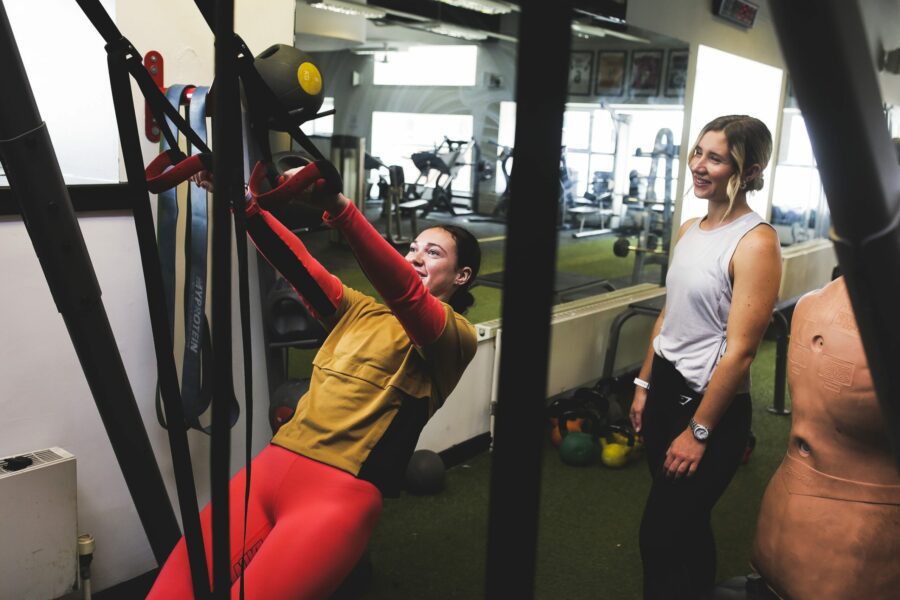
While taking on pregnant clients as a personal trainer might sound a bit daunting, it’s well worth learning a little more about. Not only can it be a very rewarding direction to take in terms of personal satisfaction, but it can be lucrative as well. That makes it incredibly useful if you’re trying to grow your personal trainer business.
However, before you start advertising your PT services to either new clients or a client who has recently announced their pregnancy, it’s important to know the facts. Here’s everything you need to know.
Contents
- 1 Is It Safe for Pregnant Women to Exercise?
- 2 What’s the Difference between Prenatal and Postnatal?
- 3 The Responsibility of Training Pre and Postnatal Clients
- 4 Reasons to Get a Pre and Postnatal Qualification
- 5 Tips for Training with Pregnant Clients
- 6 What Kinds of Exercise Are Safe for Prenatal Clients?
- 7 Introducing Postnatal Exercise
- 8 Become a Better Personal Trainer
Is It Safe for Pregnant Women to Exercise?
While it’s recommended for most women to exercise when pregnant, they need to do so safely. The NHS recommends that if your clients were active before they became pregnant, they should carry on with their usual level of workout for as long as it remains comfortable. For personal trainers, that’s going to mean learning more about how best to safely train your pregnant clients. You will not be able to take on pre or postnatal clients without the relevant qualification.
Of course, if you take on a pregnant client who is new to exercise, launching into a challenging and strenuous training schedule can be dangerous for both the client and the baby. So if the client is used to exercising, you can continue with their usual routine (with some modifications due to some exercise elements needing to be adapted) for a month or two. If they’re new to exercise, start them off slowly (around 15-minutes of exercise three times per week) and gradually work up to about 30-minutes of daily workout sessions.
This means that, like all of your new clients, you should take the time to evaluate their current level of fitness before making any decisions about workout intensity.
Is it safe to work out when pregnant? It is, as long as that exercise is controlled and not too strenuous. Precautions are going to be necessary, but exercising when pregnant comes with some great benefits, including:
- Reduces the potential for health problems to develop in both the mother and the baby
- Staying fit during pregnancy makes labour much easier
- Sticking with some form of light exercise will make it much easier to get back to pre-pregnancy shape once the baby has been born
- Exercise can reduce many troublesome symptoms of being pregnant (for example, backache may be avoided with some light exercise)
- Exercise has been proven to improve mood and boost energy
- Can prevent the development of type 2 diabetes
- Even light exercise can reduce and relieve constipation and bloating.
So with such a great range of benefits, it’s not surprising that more pregnant women are signing up with personal trainers in the UK. And that’s a fantastic opportunity for you to add a niche service to your range as a personal trainer. There are plenty of benefits to becoming a pre and postnatal specialist personal trainer, so it’s always worth learning more about.
What’s the Difference between Prenatal and Postnatal?
While pre and postnatal are generally grouped under the umbrella term “pregnancy”, the two are very different. A postnatal client will need a very different training schedule compared to a prenatal client.
- Prenatal: Women who are currently pregnant
- Postnatal: Clients who have recently given birth.
So with prenatal clients, the goal should be to introduce specific exercises to make giving birth (and being pregnant) easier. For your postnatal clients, the goal will be to restore health and fitness levels to pre-pregnancy levels.

The Responsibility of Training Pre and Postnatal Clients
The body goes through many changes during pregnancy, and safety needs to be a clear focus throughout. It can be a lot of responsibility, so you mustn’t take on any pre or postnatal clients until you have the necessary training. That will mean a Level 3 Pre and Postnatal Personal Training certification.
During this necessary training, you will learn all about the changes the body goes through during pregnancy and the nutritional needs of the mother and the developing baby.
Reasons to Get a Pre and Postnatal Qualification
As well as the health benefits to the pregnant and postnatal clients, there are many reasons why personal trainers should consider getting a pre and postnatal qualification. It takes a lot more than simply Googling how to train pregnant clients if you want to do it safely! Some of the main reasons to get qualified as a pre and postnatal personal trainer include the following.
Keeping Clients
We have a lot of qualified personal trainers coming to The Fitness Group who want to get their pre and postnatal qualification as quickly as possible. That’s often down to one of their existing clients having become pregnant. If you cannot support your clients correctly, they’ll find a personal trainer who can. And chances are, they’ll stick with that PT even after they’ve given birth and gone through full recovery. That’s why it’s always best to get your pre and postnatal certification in advance.
Larger Client Pool
In 2021, there were around 712,000 births in the UK. That’s a lot of potential clients! With the many benefits of exercising pre and post-pregnancy, being able to sign those pregnant clients can only be a good thing for your potential to grow your personal trainer business. We always advise our students to find a niche. Some will earn a qualification in kettlebell training (an incredibly popular option as interest and uptake in kettlebell exercise is growing) or a sports massage diploma.
The Professional Touch
As a qualified personal trainer, you’re a part of the health industry. And just as nobody would go to a dermatologist for advice about their heart conduction, no pregnant client will want advice about exercising while pregnant from a PT who doesn’t have the right qualifications. It’s all about “scope of field” (the range of services you’re qualified to deliver safely). With a certificate in pre and postnatal exercise, you can show prospective clients that your scope of field is relevant to their needs.
Avoiding Risk
If you’ve had a client for a few years and they announce they’re pregnant, you might be tempted to keep them as your client for as long as possible. You take to Google and start making notes about the best exercise and what to avoid. The problem is that the internet is a goldmine of misinformation. And if you push a pregnant client further than you should or introduce exercises that can cause harm to the mother and the baby, you’re risking your reputation, and you could end up in court.
If you study with The Fitness Group, you know that your pre and postnatal certification is accredited by Ofqual (and appears on the Regulated Qualifications Framework with the Accreditation number 603/3592/0), The Chartered Institute for the Management of Sport and Physical Activity (CIMSPA), UK Active and REPs (Register of Exercise Professionals).
Tips for Training with Pregnant Clients
It’s easy to make mistakes if you’ve never taken on a pre or postnatal client. Two of the most common mistakes made by personal trainers new to this demographic are:
Sticking to the Same Routine Throughout
The human body goes through a tremendous number of changes throughout pregnancy. One of the most common mistakes made by personal trainers who lack experience and certification when taking on pregnant clients is to design a workout routine that stays the same for nine months. Training programs need to evolve throughout and after the pregnancy.
That evolution needs to occur according to the trimester and be flexible enough to change depending on the comfort of the client. One of the key things you’ll learn during your Level 3 Pre and Postnatal qualification is to listen to your client. If they feel uncomfortable with a certain type of exercise, find an alternative.
Sharing, Not Scaring
This is one of the most consistently given pieces of advice you’ll find. As a fitness professional, your job will be to educate your pregnant clients about their bodies so that you can support them as their bodies change. Some of the topics you’ll learn about can feel overwhelming or even daunting, but the more you know, the better a personal trainer you’ll be for your clients.
So as part of your ongoing development to meet your target of becoming a successful personal trainer, you’re going to need to learn about the following:
- Pelvic organ prolapse
- Incontinence
- Diastasis recti
- Pelvic floor dysfunction.
The key here is to focus on what your client can do, not what they shouldn’t do. Share knowledge and experience, don’t scare your clients with horror stories.
What Kinds of Exercise Are Safe for Prenatal Clients?
While every pre and postnatal client will be different, with a range of needs and restrictions, some exercises are consistently useful. These will generally be in the regular, moderate-intensity level of physical activity. So for prenatal clients, the exercises you’ll be adding to training programs will include:
- Swimming
- Walking
- Yoga (this needs to be approached carefully, as some prone yoga positions can be a risk)
- Strength training
- Pilates
- Low impact aerobics.
The exercises you will need to avoid are ones that put the health of the mother or the baby at risk, including:
- Exercise/activities that have a risk of falling (horse riding, skiing, etc.)
- Contact sports
- Planks and push-ups
- Any exercise that puts pressure on the pelvic floor
- Sit-ups
- Crunches.
You may also find that some clients will be advised not to do any exercise during their pregnancy. They may have some high-risk factors for preterm labour, vaginal bleeding or the risk of premature rupture of membranes. In those cases, it’s common sense to follow doctors’ advice and focus instead on nutritional needs and meal plans rather than exercise.
Another thing to be aware of is when you need to stop a session with a pregnant client. If any of the following happen, stop the session immediately:
- Dizziness
- Vaginal bleeding
- Chest pain
- Headache
- Shortness of breath
- Sudden muscles weakness
- Swelling calves (or sudden pain in the calves)
- Painful contractions
- Amniotic fluid leaks.
If any discomfort occurs, stop the session immediately. If any of the above occurs, don’t just stop the session; call for medical help too.

Introducing Postnatal Exercise
There are many benefits to physical activity after pregnancy, such as reducing the risk of postpartum depression and improving cardiovascular health levels without disrupting milk production. There will likely be a recovery period after giving birth, but physical activity can be gradually increased in the six weeks following labour. Make sure you do the following with postnatal clients:
- Get clearance from the client’s doctor that exercise can be safely managed
- Start slowly
- It’s a good idea to begin with simple walking workouts
- Don’t push your postnatal clients far enough to cause excessive fatigue
- Always ensure your postnatal clients are wearing a supportive sports bra
- Encourage drinking plenty of water
- Always stop a session if the client is starting to bleed from their vagina.
Become a Better Personal Trainer
There are many reasons to become a personal trainer, but if you want to be more successful, focusing on delivering niche services is a good idea. Pre and postnatal specialists are in high demand, so it makes sense to learn more about how to train this unique demographic.
If you already have your Level 2 Fitness Instructing qualification, a Level 2 Certificate in Gym Instructing or an equivalent qualification, you can sign up for our Level 3 Pre and postnatal Qualification today. You’ll get all the training you need to ensure you can keep your pre and postnatal clients safe even as you help them maintain their health levels throughout and after their pregnancy.
We can even help you when it comes to your finances, with a range of payment options that make getting your advanced qualification significantly easier. So there are fewer barriers than ever when it comes to growing your business as a personal trainer. Contact the team at the Fitness Group today, and we’ll talk you through everything you need to know to become a pre and postnatal personal trainer.

